Coupling Agricultural Green Development and Park City Development: An Empirical Analysis from Chengdu, China
Abstract
1. Introduction
2. Literature Review
3. Methods and Data
3.1. Overview of the Study Area
3.2. Evaluation System of Green Agricultural Development and Park City in Chengdu
3.3. Setting Weights with the Entropy Method
3.4. Gray Correlation Analysis
3.5. Coupling Coordination Model
3.6. Spatial Autocorrelation Test
3.7. Data Sources
4. Findings
4.1. Time-Series Characteristics of the AGD Level in Prefecture-Level Cities in Sichuan Province
4.2. Time-Series Characteristics of the PCD Level in Prefecture-Level Cities in Sichuan Province
4.3. Analysis of Gray Correlation Degree Between Agricultural Green Development and Park City in Sichuan Province
4.4. Timing Characteristics of Coupling Degree and Coupling Coordination Degree Between AGD and PCD
4.5. Spatial Autocorrelation Analysis
5. Conclusions and Policy Implications
5.1. Conclusions
5.2. Policy Implications
Author Contributions
Funding
Institutional Review Board Statement
Informed Consent Statement
Data Availability Statement
Conflicts of Interest
Abbreviations
| AGD | Agricultural green development |
| PCD | Park city development |
| ACER | Agriculture carbon emission reduction |
References
- Chen, X. The core of China’s rural revitalization: Exerting the functions of rural area. China Agric. Econ. Rev. 2020, 12, 1–13. [Google Scholar] [CrossRef]
- Sharifi, A.; Khavarian-Garmsir, A.R. The COVID-19 pandemic: Impacts on cities and major lessons for urban planning, design, and management. Sci. Total Environ. 2020, 749, 142391. [Google Scholar] [CrossRef] [PubMed]
- Fanfani, D.; Duží, B.; Mancino, M.; Rovai, M. Multiple evaluation of urban and peri-urban agriculture and its relation to spatial planning: The case of Prato territory (Italy). Sustain. Cities Soc. 2022, 79, 103636. [Google Scholar] [CrossRef]
- Hosseinpour, N.; Kazemi, F.; Mahdizadeh, H. A cost-benefit analysis of applying urban agriculture in sustainable park design. Land Use Policy 2022, 112, 105834. [Google Scholar] [CrossRef]
- Li, Y.; Westlund, H.; Liu, Y. Why some rural areas decline while some others not: An overview of rural evolution in the world. J. Rural Stud. 2019, 68, 135–143. [Google Scholar] [CrossRef]
- Wen, T. Eight crises: Lessons from China 1949–2009. In Development Trap and Experience in China; Oriental Press: Beijing, China, 2013. [Google Scholar]
- Long, H.; Tu, S.; Ge, D.; Li, T.; Liu, Y. The allocation and management of critical resources in rural China under restructuring: Problems and prospects. J. Rural Stud. 2016, 47, 392–412. [Google Scholar] [CrossRef]
- Fei, X.; Feng, J.W. Research on the High-Quality Development Model of China’s Grain Industry from the Perspective of Rural Revitalization. Wirel. Commun. Mob. Comput. 2022, 2022, 2661237. [Google Scholar] [CrossRef]
- Zoomers, A.; van Noorloos, F.; Otsuki, K.; Steel, G.; van Westen, G. The Rush for Land in an Urbanizing World: From Land Grabbing Toward Developing Safe, Resilient, and Sustainable Cities and Landscapes. World Dev. 2017, 92, 242–252. [Google Scholar] [CrossRef]
- Huang, M.H.; Xiao, J.; Zhou, Y.T. From Garden City to Public Garden City: The Actuality, Oughtness, and Inevitability of Theoretical Innovation of Urban Planning with Chinese Characteristics. Planners 2022, 38, 140–145. [Google Scholar]
- Sharifi, A. From Garden City to Eco-urbanism: The quest for sustainable neighborhood development. Sustain. Cities Soc. 2016, 20, 1–16. [Google Scholar] [CrossRef]
- Fu, F.; Li, H.; Zhao, C. From landscape City to Park City—The road of urban development in China. Landsc. Archit. 2020, 36, 12. [Google Scholar]
- Yu, G.; Wu, S.; Huang, S.; Huang, X. From “City of a Thousand Parks” to “City as a Park”: Compilation Idea and Practice of the Outline of Shenzhen Park City Planning. Landsc. Archit. 2023, 30, 69–77. [Google Scholar]
- Shi, Y.; Liu, Q. Park City: Connotation, Logic and Path of Green Governance. J. Renmin Univ. China 2019, 33, 48. [Google Scholar]
- Wu, S.; Wang, D.; Yan, Z.; Wang, X.; Han, J. Coupling or contradiction? The spatiotemporal relationship between urbanization and urban park system development in China. Ecol. Indic. 2023, 154, 110703. [Google Scholar] [CrossRef]
- Xie, X.; Gong, X.; Pan, S. Research on the construction path of the megacity from the perspective of Nudge Theory: Empirical evidence of the “Park City” construction in Chengdu Tianfu New Area. Chin. J. Popul. Res. Environ. 2023, 21, 163–171. [Google Scholar] [CrossRef]
- Zhang, Z.; Ma, G.; Lin, X.; Dai, H. Accessibility in a multiple transport mode urban park based on the “D-D” model: A case study in Park City, Chengdu. Cities 2023, 134, 104191. [Google Scholar] [CrossRef]
- Zhang, S.; Song, H.; Li, X.; Luo, S. Urban Parks Quality Assessment Using Multi-Dimension Indicators in Chengdu, China. Land 2024, 13, 86. [Google Scholar] [CrossRef]
- Tan, R.; Wang, R.; Wang, Y.; Yi, D.; Chen, Y.; Cai, W.; Wang, X. The Park city perspective study: Revealing the park accessibility influenced by experiences of visitors under different travel modes. Front. Environ. Sci. 2022, 10, 924996. [Google Scholar] [CrossRef]
- Li, Z.; Liu, Q.; Zhang, Y.; Yan, K.; Yan, Y.; Xu, P. Characteristics of Urban Parks in Chengdu and Their Relation to Public Behaviour and Preferences. Sustainability 2022, 14, 6761. [Google Scholar] [CrossRef]
- Zhang, J.; Xu, E. Investigating the spatial distribution of urban parks from the perspective of equity-efficiency: Evidence from Chengdu, China. Urban For. Urban Green. 2023, 86, 128019. [Google Scholar] [CrossRef]
- Azunre, G.A.; Amponsah, O.; Peprah, C.; Takyi, S.A.; Braimah, I. A review of the role of urban agriculture in the sustainable city discourse. Cities 2019, 93, 104–119. [Google Scholar] [CrossRef]
- La Rosa, D.; Barbarossa, L.; Privitera, R.; Martinico, F. Agriculture and the city: A method for sustainable planning of new forms of agriculture in urban contexts. Land Use Policy 2014, 41, 290–303. [Google Scholar] [CrossRef]
- Benis, K.; Ferrão, P. Potential mitigation of the environmental impacts of food systems through urban and peri-urban agriculture (UPA)—A life cycle assessment approach. J. Clean. Prod. 2017, 140, 784–795. [Google Scholar] [CrossRef]
- Hara, Y.; McPhearson, T.; Sampei, Y.; McGrath, B. Assessing urban agriculture potential: A comparative study of Osaka, Japan and New York city, United States. Sustain. Sci. 2018, 13, 937–952. [Google Scholar] [CrossRef]
- Rallings, A.M.; Smukler, S.M.; Gergel, S.E.; Mullinix, K. Towards multifunctional land use in an agricultural landscape: A trade-off and synergy analysis in the Lower Fraser Valley, Canada. Landsc. Urban Plan. 2019, 184, 88–100. [Google Scholar] [CrossRef]
- Renting, H.; Rossing, W.A.H.; Groot, J.C.J.; Van der Ploeg, J.D.; Laurent, C.; Perraud, D.; Stobbelaar, D.J.; Van Ittersum, M.K. Exploring multifunctional agriculture. A review of conceptual approaches and prospects for an integrative transitional framework. J. Environ. Manag. 2009, 90, S112–S123. [Google Scholar] [CrossRef]
- Peng, J.; Liu, Z.; Liu, Y.; Hu, X.; Wang, A. Multifunctionality assessment of urban agriculture in Beijing City, China. Sci. Total Environ. 2015, 537, 343–351. [Google Scholar] [CrossRef]
- Yang, Z.; Cai, J.; Sliuzas, R. Agro-tourism enterprises as a form of multi-functional urban agriculture for peri-urban development in China. Habitat Int. 2010, 34, 374–385. [Google Scholar] [CrossRef]
- Barthel, S.; Parker, J.; Ernstson, H. Food and green space in cities: A resilience lens on gardens and urban environmental movements. Urban Stud. 2015, 52, 1321–1338. [Google Scholar] [CrossRef]
- McClintock, N.; Miewald, C.; McCann, E. Governing urban agriculture: Formalization, resistance and re-visioning in two ‘green’ cities. Int. J. Urban Reg. Res. 2021, 45, 498–518. [Google Scholar] [CrossRef]
- Nogeire-McRae, T.; Ryan, E.P.; Jablonski, B.B.R.; Carolan, M.; Arathi, H.S.; Brown, C.S.; Saki, H.H.; McKeen, S.; Lapansky, E.; Schipanski, M.E. The role of urban agriculture in a secure, healthy, and sustainable food system. BioScience 2018, 68, 748–759. [Google Scholar] [CrossRef]
- Rao, N.; Patil, S.; Singh, C.; Roy, P.; Pryor, C.; Poonacha, P.; Genes, M. Cultivating sustainable and healthy cities: A systematic literature review of the outcomes of urban and peri-urban agriculture. Sustain. Cities Soc. 2022, 85, 104063. [Google Scholar] [CrossRef]
- Weidner, T.; Yang, A. The potential of urban agriculture in combination with organic waste valorization: Assessment of resource flows and emissions for two European cities. J. Clean. Prod. 2020, 244, 118490. [Google Scholar] [CrossRef]
- Gómez-Villarino, M.T.; Ruiz-Garcia, L. Adaptive design model for the integration of urban agriculture in the sustainable development of cities. A case study in northern Spain. Sustain. Cities Soc. 2021, 65, 102595. [Google Scholar] [CrossRef]
- Panagopoulos, T.; Duque, J.A.G.; Dan, M.B. Urban planning with respect to environmental quality and human well-being. Environ. Pollut. 2016, 208, 137–144. [Google Scholar] [CrossRef]
- Kulak, M.; Graves, A.; Chatterton, J. Reducing greenhouse gas emissions with urban agriculture: A Life Cycle Assessment perspective. Landsc. Urban Plan. 2013, 111, 68–78. [Google Scholar] [CrossRef]
- Langemeyer, J.; Madrid-Lopez, C.; Beltran, A.M.; Mendez, G.V. Urban agriculture—A necessary pathway towards urban resilience and global sustainability? Landsc. Urban Plan. 2021, 210, 104055. [Google Scholar] [CrossRef]
- Cohen, N.; Wijsman, K. Urban agriculture as green infrastructure: The case of New York city. Urban Agric. Mag. 2014, 27, 16–19. [Google Scholar]
- McCarthy, L.J.; Russo, A. Exploring the role of nature-based typologies and stewardship schemes in enhancing urban green spaces: Citizen perceptions of landscape design scenarios and ecosystem services. J. Environ. Manag. 2023, 346, 118944. [Google Scholar] [CrossRef]
- Bai, X.; Sadia, S. Park city leads the way of urban development and innovation in China. J. Environ. Eng. Landsc. Manag. 2023, 31, 240–247. [Google Scholar] [CrossRef]
- Wu, X.; Liu, H.; Liu, W. Exploring the spatiotemporal evolution dynamic and influencing factor of green ecology transition for megacities: A case study of Chengdu, China. Ecol. Indic. 2024, 158, 111285. [Google Scholar] [CrossRef]
- Chen, Z.; Sarkar, A.; Rahman, A.; Li, X.; Xia, X. Exploring the drivers of green agricultural development (GAD) in China: A spatial association network structure approaches. Land Use Policy 2022, 112, 105827. [Google Scholar] [CrossRef]
- Liu, Y.; Sun, D.; Wang, H.; Wang, X.; Yu, G.; Zhao, X. An evaluation of China’s agricultural green production: 1978–2017. J. Clean. Prod. 2020, 243, 118483. [Google Scholar] [CrossRef]
- Cui, X.; Zhao, T.; Wang, J. Allocation of carbon emission quotas in China’s provincial power sector based on entropy method and ZSG-DEA. J. Clean. Prod. 2021, 284, 124683. [Google Scholar] [CrossRef]
- Hu, Y.; Wu, L.; Shi, C.; Wang, Y.; Zhu, F. Research on optimal decision-making of cloud manufacturing service provider based on grey correlation analysis and TOPSIS. Int. J. Prod. Res. 2020, 58, 748–757. [Google Scholar] [CrossRef]
- Zhang, J.; Dong, Z. Assessment of coupling coordination degree and water resources carrying capacity of Hebei Province (China) based on WRESP2D2P framework and GTWR approach. Sustain. Cities Soc. 2022, 82, 103862. [Google Scholar] [CrossRef]
- Dong, Q.; Zhong, K.; Liao, Y.; Xiong, R.; Wang, F.; Pang, M. Coupling coordination degree of environment, energy, and economic growth in resource-based provinces of China. Resour. Policy 2023, 81, 103308. [Google Scholar] [CrossRef]
- Wu, B.; Liu, L. Social capital for rural revitalization in China: A critical evaluation on the government’s new countryside programme in Chengdu. Land Use Policy 2020, 91, 104268. [Google Scholar] [CrossRef]
- Du, Y. Holistic gentrification and the recreation of rurality: The new wave of rural gentrification in Chengdu, China. J. Rural Stud. 2022, 96, 237–245. [Google Scholar] [CrossRef]
- Zhong, C.; Hu, R.; Wang, M.; Xue, W.; He, L. The impact of urbanization on urban agriculture: Evidence from China. J. Clean. Prod. 2020, 276, 122686. [Google Scholar] [CrossRef]
- Gan, L.; Shi, H.; Hu, Y.; Lev, B.; Lan, H. Coupling coordination degree for urbanization city-industry integration level: Sichuan case. Sustain. Cities Soc. 2020, 58, 102136. [Google Scholar] [CrossRef]
- Tang, D.; Mao, M.; Shi, J.; Hua, W. The spatio-temporal analysis of urban-rural coordinated development and its driving forces in Yangtze River Delta. Land 2021, 10, 495. [Google Scholar] [CrossRef]

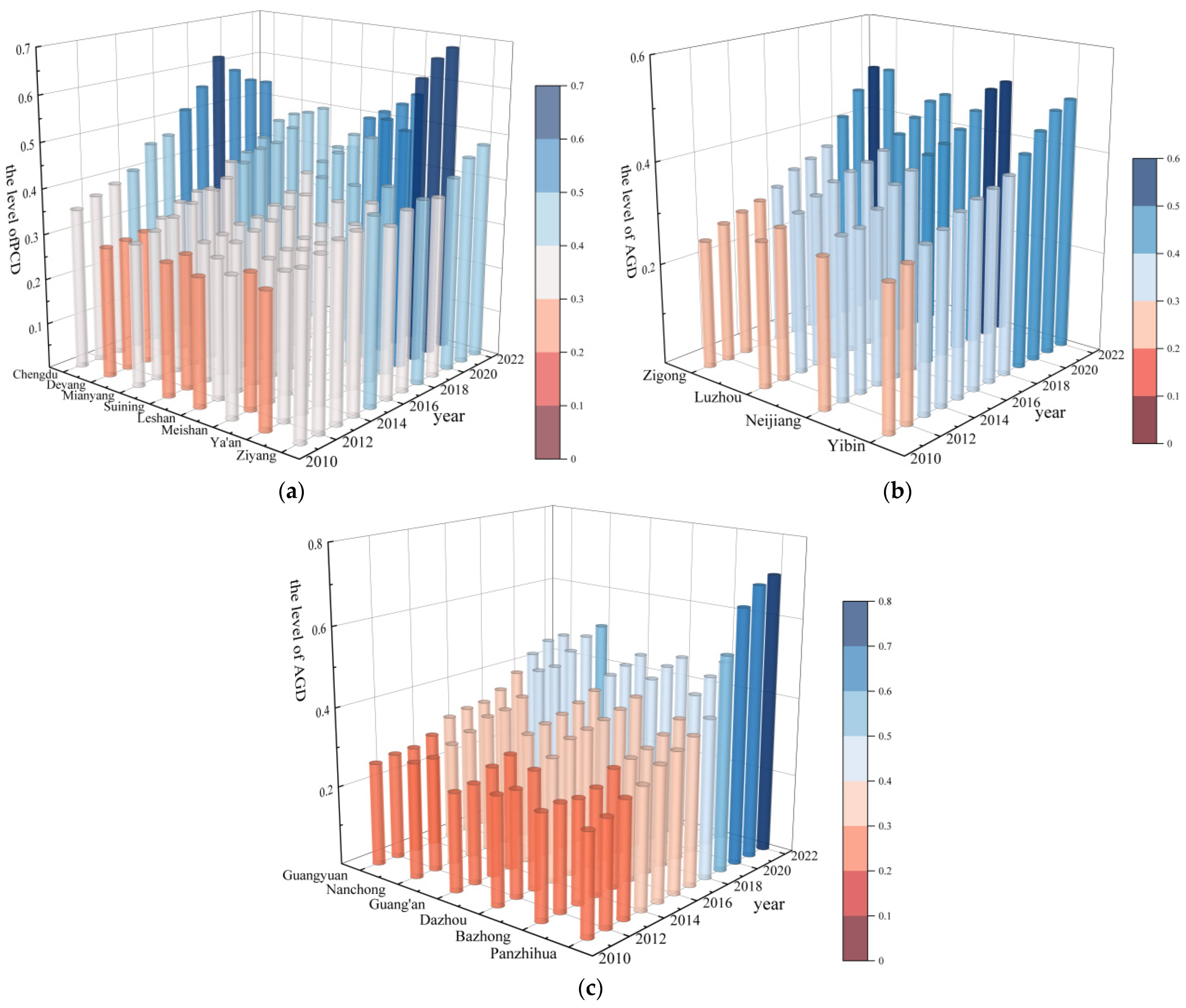

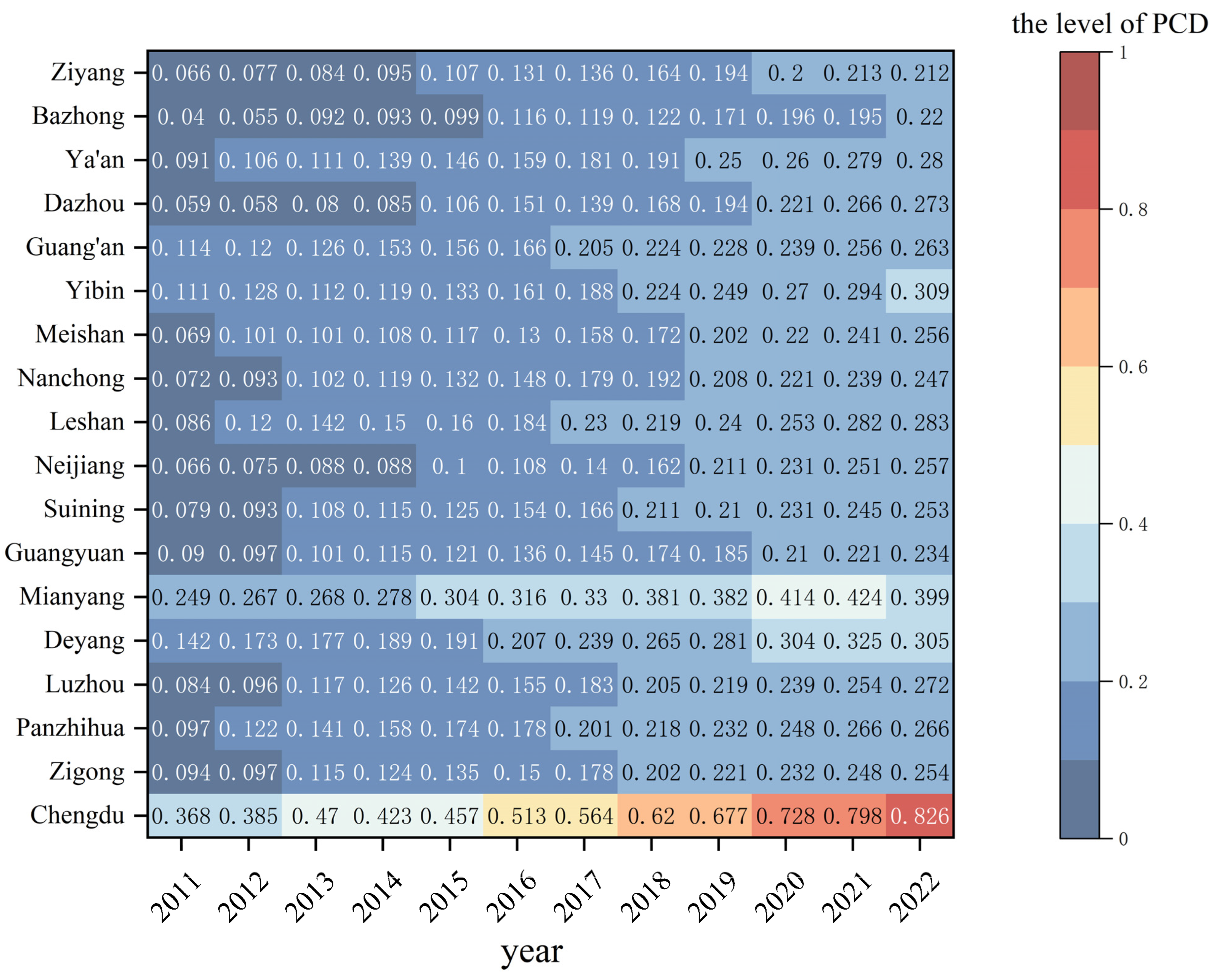

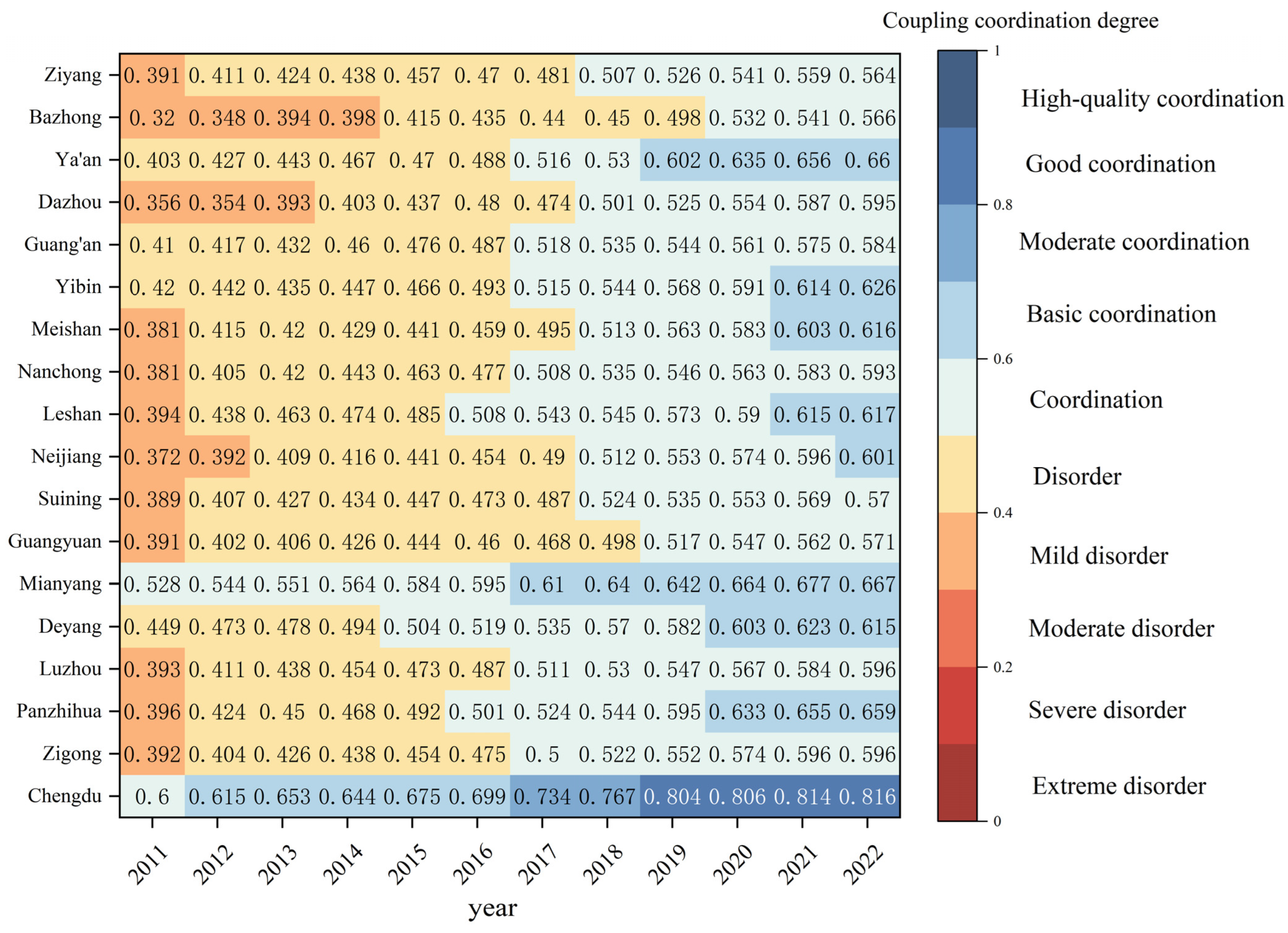
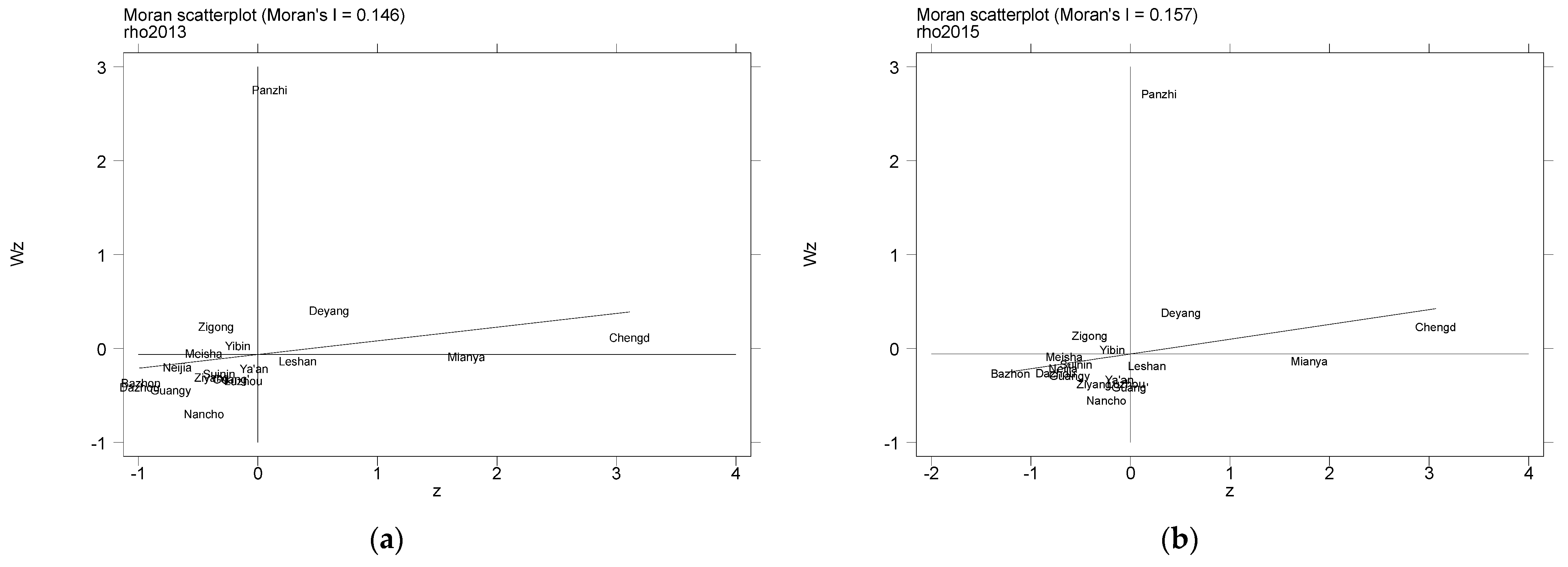
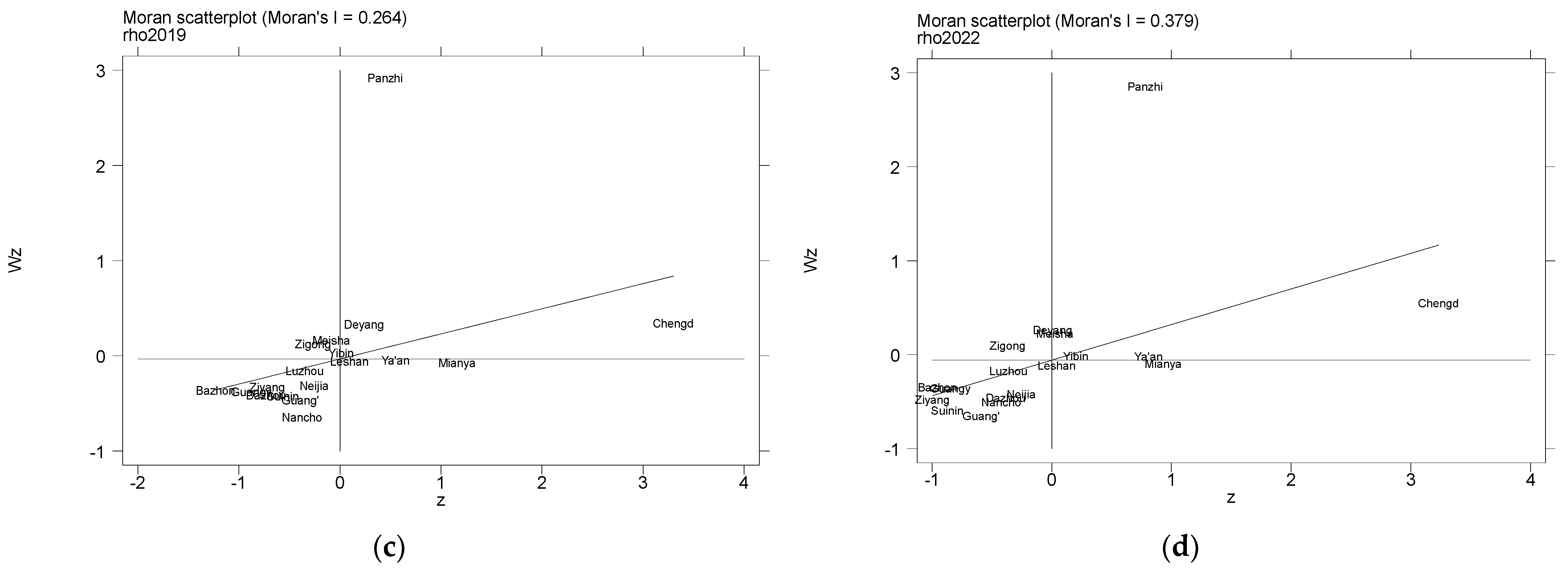
| Primary Indicators | Secondary Indicators | Vectors | Characteristics | Weight W |
|---|---|---|---|---|
| Habitat Living Environment (0.265) | Number of parks | Positive | 0.151 | |
| Per capita public recreational green space | Positive | 0.054 | ||
| Urban sewage treatment rate | Positive | 0.007 | ||
| Harmless treatment rate of domestic garbage | Positive | 0.008 | ||
| Road square per capita (m2) | Positive | 0.044 | ||
| Urban Ecological Environment (0.041) | Proportion of days with good ambient air quality | Positive | 0.010 | |
| Green space rate of built district (%) | Positive | 0.015 | ||
| Green coverage rate of built-up areas (%) | Positive | 0.016 | ||
| Green Production Status (0.694) | Share of tertiary industry GDP in total GDP | Positive | 0.062 | |
| GDP per capita | Positive | 0.054 | ||
| Value added of tertiary industry | Positive | 0.345 | ||
| Per capita disposable income of urban residents | Positive | 0.055 | ||
| Intensity of R&D investment | Positive | 0.178 |
| Primary Indicators | Secondary Indicators | Meaning of the Indicator | Vectors | Characteristics | Weight W |
|---|---|---|---|---|---|
| Resource Saving (0.217) | Cropland replanting coefficient | Sown area of major crops/total cultivated area | Negative | 0.063 | |
| Total power of agricultural machinery per unit sown area | Total power of agricultural machinery/area sown with crops | Negative | 0.039 | ||
| Percentage of effective irrigated area | Effective irrigated area/total cultivated area | Positive | 0.115 | ||
| Ecological Conservation (0.185) | Intensity of pesticide usage | Pesticide application/area sown with crops | Negative | 0.004 | |
| Intensity of fertilizer use | Agricultural fertilizer application/area sown with crops | Negative | 0.069 | ||
| Intensity of agricultural plastic film use | Agricultural film use/area sown with crops | Negative | 0.035 | ||
| Forest coverage rate | Ratio of forest area/total land area | Positive | 0.077 | ||
| Efficient Development (0.452) | Level of contribution of the agricultural economy | (Agricultural output/regional GDP) × 100 | Positive | 0.083 | |
| The per unit area yield of grain | Total grain production/total area sown with grain | Positive | 0.028 | ||
| Total agricultural output per sown area | Gross agricultural output/area sown for major crops | Positive | 0.173 | ||
| Agricultural labor productivity | Gross value of agricultural output/personnel employed in the primary sector | Positive | 0.168 | ||
| Green Life (0.145) | Per capita disposable income of rural residents | Rural disposable income per capita | Positive | 0.105 | |
| Engel’s coefficient for rural households | Engel’s coefficient for rural households | Positive | 0.041 |
| Category of Coupling Coordination | Value | Coupling Coordination Level |
|---|---|---|
| Bad Coupling Coordination | (0, 0.1] | Extreme disorder |
| (0.1, 0.2] | Severe disorder | |
| (0.2, 0.3] | Moderate disorder | |
| (0.3, 0.4] | Mild disorder | |
| (0.4, 0.5] | Disorder | |
| Good Coupling Coordination | (0.5, 0.6] | Coordination |
| (0.6, 0.7] | Basic coordination | |
| (0.7, 0.8] | Moderate coordination | |
| (0.8, 0.9] | Good coordination | |
| (0.9, 1.0] | High-quality coordination |
| Chengdu | Zigong | Panzhihua | Luzhou | Deyang | Mianyang | Guangyuan | Suining | Neijiang | |||
|---|---|---|---|---|---|---|---|---|---|---|---|
| Agricultural green development system (Y) | Resource saving | 0.716 | 0.570 | 0.395 | 0.527 | 0.729 | 0.673 | 0.623 | 0.578 | 0.620 | |
| 0.723 | 0.393 | 0.742 | 0.420 | 0.441 | 0.525 | 0.464 | 0.389 | 0.414 | |||
| 0.719 | 0.804 | 0.683 | 0.794 | 0.700 | 0.749 | 0.758 | 0.725 | 0.727 | |||
| Ecological conservation | 0.767 | 0.511 | 0.531 | 0.510 | 0.541 | 0.622 | 0.498 | 0.505 | 0.511 | ||
| 0.765 | 0.511 | 0.874 | 0.433 | 0.956 | 0.816 | 0.451 | 0.696 | 0.491 | |||
| 0.775 | 0.444 | 0.791 | 0.419 | 0.532 | 0.540 | 0.458 | 0.405 | 0.403 | |||
| 0.639 | 0.865 | 0.375 | 0.483 | 0.641 | 0.550 | 0.405 | 0.820 | 0.840 | |||
| Efficient Development | 0.466 | 0.803 | 0.857 | 0.851 | 0.893 | 0.816 | 0.634 | 0.735 | 0.638 | ||
| 0.642 | 0.622 | 0.754 | 0.437 | 0.422 | 0.723 | 0.571 | 0.532 | 0.505 | |||
| 0.595 | 0.932 | 0.727 | 0.849 | 0.847 | 0.658 | 0.795 | 0.902 | 0.948 | |||
| 0.675 | 0.807 | 0.713 | 0.890 | 0.796 | 0.807 | 0.821 | 0.844 | 0.530 | |||
| Green life | 0.743 | 0.617 | 0.600 | 0.656 | 0.648 | 0.703 | 0.727 | 0.647 | 0.610 | ||
| 0.780 | 0.550 | 0.491 | 0.563 | 0.549 | 0.574 | 0.500 | 0.549 | 0.549 | |||
| Leshan | Nanchong | Meishan | Yibin | Guang’an | Dazhou | Ya’an | Bazhong | Ziyang | |||
| Agricultural green development system (Y) | Resource saving | 0.558 | 0.682 | 0.520 | 0.489 | 0.513 | 0.564 | 0.523 | 0.609 | 0.500 | |
| 0.563 | 0.390 | 0.523 | 0.431 | 0.479 | 0.387 | 0.789 | 0.389 | 0.399 | |||
| 0.659 | 0.821 | 0.451 | 0.817 | 0.799 | 0.801 | 0.546 | 0.746 | 0.797 | |||
| Ecological conservation | 0.526 | 0.501 | 0.496 | 0.519 | 0.519 | 0.502 | 0.517 | 0.487 | 0.500 | ||
| 0.545 | 0.486 | 0.837 | 0.391 | 0.524 | 0.499 | 0.909 | 0.493 | 0.359 | |||
| 0.487 | 0.444 | 0.603 | 0.452 | 0.536 | 0.451 | 0.395 | 0.449 | 0.367 | |||
| 0.420 | 0.656 | 0.501 | 0.568 | 0.731 | 0.584 | 0.341 | 0.364 | 0.687 | |||
| Efficient Development | 0.910 | 0.598 | 0.681 | 0.819 | 0.668 | 0.581 | 0.673 | 0.570 | 0.475 | ||
| 0.567 | 0.515 | 0.519 | 0.465 | 0.452 | 0.509 | 0.848 | 0.487 | 0.773 | |||
| 0.931 | 0.902 | 0.860 | 0.869 | 0.911 | 0.930 | 0.660 | 0.804 | 0.870 | |||
| 0.836 | 0.676 | 0.835 | 0.816 | 0.825 | 0.863 | 0.782 | 0.838 | 0.854 | |||
| Green life | 0.683 | 0.700 | 0.564 | 0.640 | 0.667 | 0.654 | 0.733 | 0.713 | 0.575 | ||
| 0.506 | 0.576 | 0.482 | 0.600 | 0.572 | 0.582 | 0.454 | 0.576 | 0.484 |
| Factors of Agricultural Green Development Influencing Park City | Gray Correlation Degree | Sort | |
|---|---|---|---|
| Resource Saving 0.599 | Cropland replanting coefficient | 0.577 | 8 |
| Total power of agricultural machinery per unit sown area | 0.492 | 13 | |
| Percentage of effective irrigated area | 0.728 | 3 | |
| Ecological Conservation 0.556 | Intensity of pesticide usage | 0.531 | 11 |
| Intensity of fertilizer use | 0.613 | 6 | |
| Intensity of agricultural plastic film use | 0.497 | 12 | |
| Forest coverage rate | 0.582 | 7 | |
| Efficient Development 0.725 | Level of contribution of the agricultural economy | 0.704 | 4 |
| The per unit area yield of grain | 0.574 | 9 | |
| Total agricultural output per sown area | 0.833 | 1 | |
| Agricultural labor productivity | 0.789 | 2 | |
| Green Life 0.606 | Per capita disposable income of rural residents | 0.660 | 5 |
| Engel’s coefficient for rural households | 0.552 | 10 |
| Factors of Agricultural Green Development Influencing Park City | Gray Correlation Degree | Sort | |
|---|---|---|---|
| Resource Saving 0.719 | Cropland replanting coefficient | 0.716 | 8 |
| Total power of agricultural machinery per unit sown area | 0.723 | 6 | |
| Percentage of effective irrigated area | 0.719 | 7 | |
| Ecological Conservation 0.736 | Intensity of pesticide usage | 0.767 | 3 |
| Intensity of fertilizer use | 0.765 | 4 | |
| Intensity of agricultural plastic film use | 0.775 | 2 | |
| Forest coverage rate | 0.639 | 11 | |
| Efficient Development 0.594 | Level of contribution of the agricultural economy | 0.466 | 13 |
| The per unit area yield of grain | 0.642 | 10 | |
| Total agricultural output per sown area | 0.595 | 12 | |
| Agricultural labor productivity | 0.675 | 9 | |
| Green Life 0.761 | Per capita disposable income of rural residents | 0.743 | 5 |
| Engel’s coefficient for rural households | 0.780 | 1 |
| Years | Moran’s I | Z | P |
|---|---|---|---|
| 2011 | 0.056 | 0.828 | 0.204 |
| 2012 | 0.128 * | 1.314 | 0.095 |
| 2013 | 0.146 * | 1.564 | 0.059 |
| 2014 | 0.146 * | 1.483 | 0.069 |
| 2015 | 0.157 * | 1.630 | 0.052 |
| 2016 | 0.110 * | 1.325 | 0.093 |
| 2017 | 0.122 * | 1.396 | 0.081 |
| 2018 | 0.096 | 1.208 | 0.114 |
| 2019 | 0.264 *** | 2.622 | 0.004 |
| 2020 | 0.356 *** | 3.211 | 0.001 |
| 2021 | 0.369 *** | 3.211 | 0.001 |
| 2022 | 0.379 *** | 3.434 | 0.000 |
Disclaimer/Publisher’s Note: The statements, opinions and data contained in all publications are solely those of the individual author(s) and contributor(s) and not of MDPI and/or the editor(s). MDPI and/or the editor(s) disclaim responsibility for any injury to people or property resulting from any ideas, methods, instructions or products referred to in the content. |
© 2025 by the authors. Licensee MDPI, Basel, Switzerland. This article is an open access article distributed under the terms and conditions of the Creative Commons Attribution (CC BY) license (https://creativecommons.org/licenses/by/4.0/).
Share and Cite
Dai, X.; Li, Y.; Qi, Y.; Chen, Y.; Yan, D.; Xia, K.; He, S.; He, Y. Coupling Agricultural Green Development and Park City Development: An Empirical Analysis from Chengdu, China. Agriculture 2025, 15, 248. https://doi.org/10.3390/agriculture15030248
Dai X, Li Y, Qi Y, Chen Y, Yan D, Xia K, He S, He Y. Coupling Agricultural Green Development and Park City Development: An Empirical Analysis from Chengdu, China. Agriculture. 2025; 15(3):248. https://doi.org/10.3390/agriculture15030248
Chicago/Turabian StyleDai, Xiaowen, Yao Li, Ying Qi, Yi Chen, Danti Yan, Keying Xia, Siyu He, and Yanqiu He. 2025. "Coupling Agricultural Green Development and Park City Development: An Empirical Analysis from Chengdu, China" Agriculture 15, no. 3: 248. https://doi.org/10.3390/agriculture15030248
APA StyleDai, X., Li, Y., Qi, Y., Chen, Y., Yan, D., Xia, K., He, S., & He, Y. (2025). Coupling Agricultural Green Development and Park City Development: An Empirical Analysis from Chengdu, China. Agriculture, 15(3), 248. https://doi.org/10.3390/agriculture15030248






